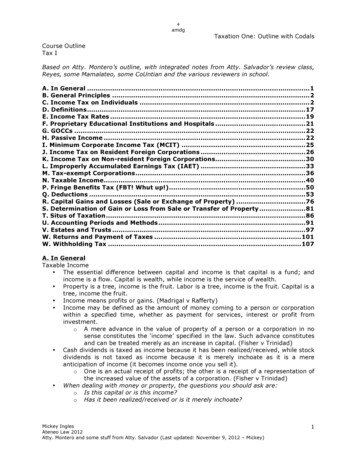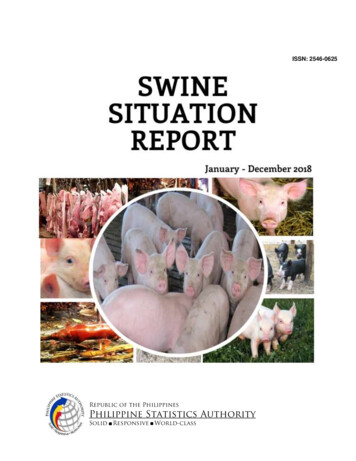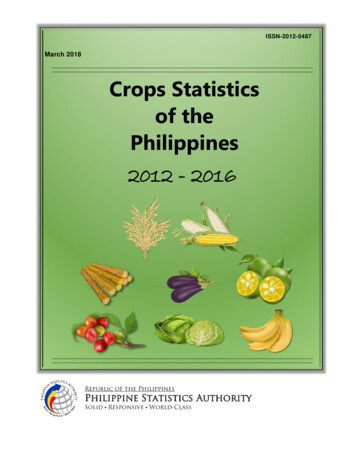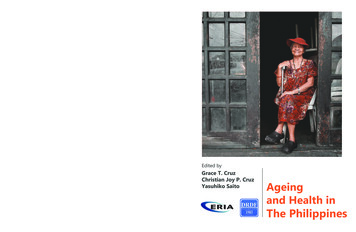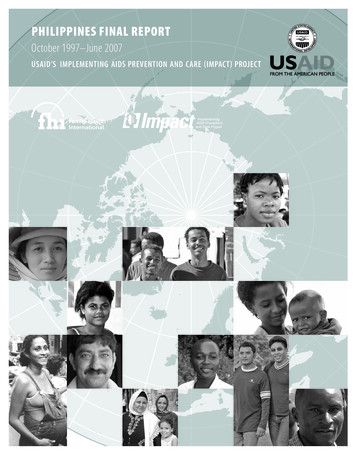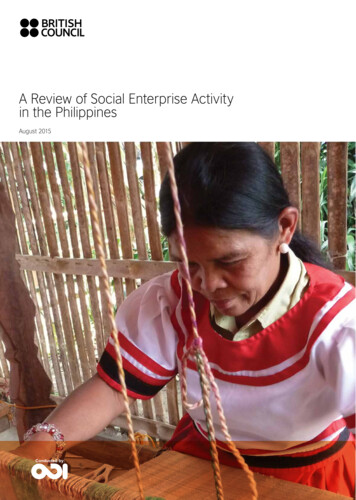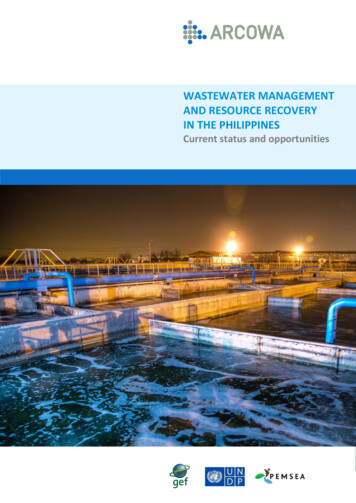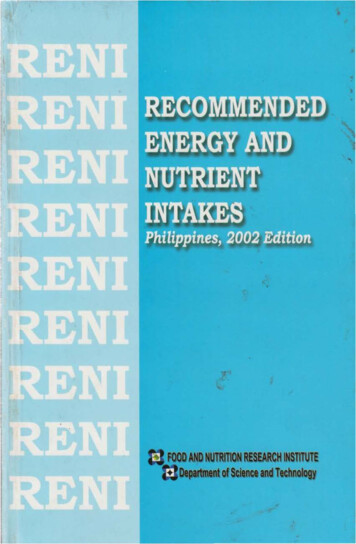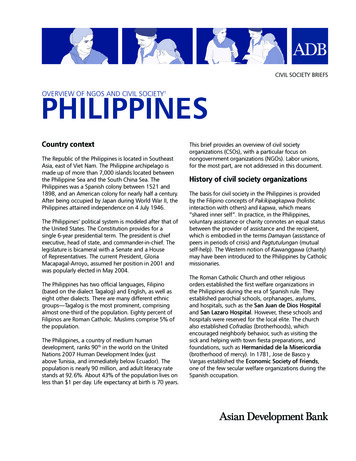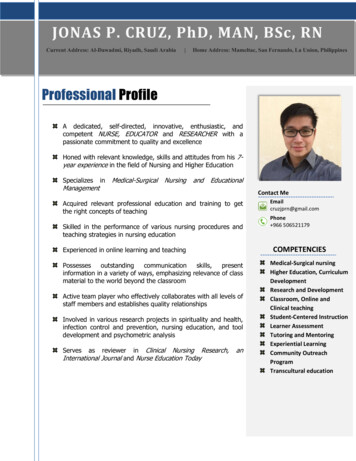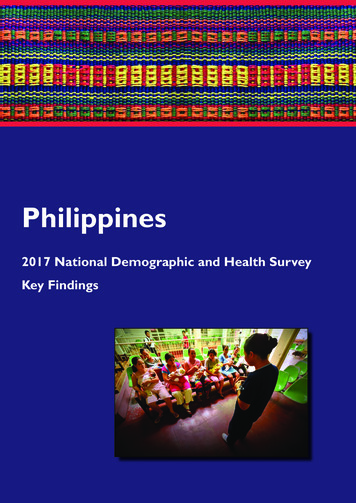
Transcription
Philippines2017 National Demographic and Health SurveyKey Findings
The 2017 Philippines National Demographic and Health Survey (NDHS 2017) was carried out by thePhilippine Statistics Authority (PSA). Funding for the NDHS 2017 was provided by the Governmentof the Philippines. The United States Agency for International Development (USAID) providedtechnical assistance and equipment through ICF under The DHS Program, which assists countries inthe collection of data to monitor and evaluate population, health, and nutrition programs. Since 1993,an NDHS has been implemented in the country approximately every five years under The DHSProgram.Additional information about the NDHS 2017 may be obtained from the Philippine Statistics Authority,PSA Complex, East Ave., Diliman, Quezon City; telephone: 63 (02)-462-6600; email:info@psa.gov.ph; internet: psa.gov.ph.Information about The DHS Program may be obtained from ICF, 530 Gaither Road, Suite 500,Rockville, MD 20850, USA; telephone: 1-301-407-6500; fax: 1-301-407-6501; email:info@DHSprogram.com; internet: www.DHSprogram.com.Recommended citation:Philippine Statistics Authority (PSA) and ICF. 2018. Key Findings from the Philippines NationalDemographic and Health Survey 2017. Quezon City, Philippines, and Rockville, Maryland, USA: PSAand ICF.Cover photograph: 2015 Allan Jay Quesada, Courtesy of Photoshare
ABOUT THE NDHS 2017The 2017 Philippines National Demographic and Health Survey (NDHS) was designed to provide datafor monitoring the population and health situation in the Philippines. The NDHS 2017 is the sixthDemographic and Health Survey (DHS) conducted in the Philippines as part of The DHS Program andthe eleventh National Demographic Survey conducted since 1968. The major objective of the survey isto provide current data on key demographic and health indicators, particularly data on household andrespondent characteristics, fertility levels, fertility preferences, marriage and sexual activity, knowledgeand use of family planning methods, childhood mortality, maternal and child health, knowledge onHIV/AIDS prevention, and domestic violence, and other health-related issues such as health insurancecoverage in the Philippines. Results from the survey can be used by program managers andpolicymakers to evaluate and improve existing programs.Who participated in the survey?A nationally representative sample of 25,074 women age 15-49 in 27,496 surveyed households wereinterviewed. This represents a response rate of 98% of women. This sample provides estimates for thePhilippines as a whole, for urban and rural areas, and for each of the 17 regions.
HOUSEHOLD & RESPONDENT CHARACTERISTICSHousehold CompositionOwnership of GoodsFilipino households consist of an average of 4.2people. Twenty-one percent of households areheaded by women. One-third of the Philippinepopulation is under age 15.Currently, 89% of Filipino households own amobile phone, 77% have a television, and 51%own a radio. Households in urban areas are morelikely than rural households to own a mobilephone, television, or radio. Only 22% ofhouseholds own a computer. Rural households aremore likely to own agricultural land or farmanimals than urban households.Housing CharacteristicsNinety-three percent of Filipino households haveaccess to electricity. Urban households are morelikely to have electricity than rural households(96% versus 90%).The majority of households (95%) use animproved source of drinking water. The mostcommon improved sources include bottledwater/refilling station (44%) and water piped intotheir homes (24%). Nine in ten urban householdsand 71% of rural households have water on thepremises. Most households (79%) report that theydo not treat their water prior to drinking.Three in four households have an improved toiletfacility. Most households (64%) have a flush orpour flush toilet to septic tank (67% in urban areasand 62% in rural areas). One-quarter of householdsuse unimproved sanitation – 17% use a sharedfacility of an otherwise acceptable type, 3% use anunimproved facility, and 5% have no facility. Sixpercent of households in rural areas have no toiletfacility, compared with only 3% of urbanhouseholds. 2014 Froi Rivera, Courtesy of PhotoshareThirty-six percent of households own a motorcycleor scooter, 19% own a bicycle, and 10% own a caror truck. Only 16% of households have a memberwho is a beneficiary of the Pantawid PamilyangPilipino Program (4Ps).Education of Survey RespondentsOnly 1% of women age 15-49 have no formaleducation, while 7% of women have completedprimary school but gone no further. More than onequarter of women have completed secondaryeducation and gone no further and 36% of womenhave more than secondary education. Women fromrural areas (31%) are less likely to have more thansecondary education, compared to women fromurban areas (43%). The median years of schoolingamongallwomenis10.6years.
FERTILITY AND ITS DETERMINANTSTotal Fertility Rate (TFR)Teenage FertilityFertility rates have steadily declined since 1993.Fertility decreased from 4.1 children per woman inthe NDS 1993 to 2.7 children per woman in theNDHS 2017 – a drop of more than one child perwoman.According to the NDHS 2017, 9% of Filipinowomen age 15-19 have begun childbearing: 7%are already mothers and an additional 2% arepregnant with their first child. Young women fromDavao are most likely to be mothers or pregnant(18% have begun childbearing). The percentage ofyoung women who have begun childbearing islower in urban areas than in rural areas (7% versus10%). Young women with some primary educationand those from the poorest households are morelikely to have begun childbearing than youngwomen with higher education levels and thosefrom the wealthiest households.Fertility varies by residence and region. Women inurban areas have 2.4 children on average,compared with 2.9 children per woman in ruralareas. Fertility is highest in Zamboanga Peninsula(3.6 children) and SOCCSKSARGEN (3.4children) and lowest in National Capital Region(1.9 children).Fertility also varies with women’s education andeconomic status. Women with no schooling havean average of 4.6 children, compared to 2.0children for women with college education.Fertility increases as household wealth decreases.Women in the poorest households have more thantwice as many children as women in the wealthiesthouseholds (4.3 versus 1.7 children per woman).Teenage Pregnancy and Motherhoodby RegionPercentage of women age 15-19 who have begunchildbearing
Age at First Sexual Intercourse, Marriage,and BirthFilipino women age 25-49 initiate sexualintercourse at a median age of 21.2 years. Eighteenpercent of women age 25-49 begin sexual activitybefore age 18.Desired Family SizeThe mean ideal family size in the Philippines is 2.7children for all women and 3.0 children forcurrently married women.The median age of first marriage for women is 22.5years, more than a year older than the median ageat first sexual intercourse. Women in urban areasmarry 1.5 years later than their counterparts in ruralareas (23.3 versus 21.8 years). In the Philippines,15% of women age 25-49 were married by age 18,and about 1 in 3 were married by age 20.Childbearing in the Philippines comes within oneyear of marriage; the median age at first birth is23.5 years. Seven percent of women have their firstbirth by age 18. Women in urban areas (24.3 years)begin childbearing 1.5 years later than women inrural areas (22.8 years). Age at first birth alsovaries by wealth; women from wealthierhouseholds wait longer to begin childbearing thanwomen from the poorest households. 2014 Froi Rivera, Courtesy of Photoshare
FAMILY PLANNINGCurrent Use of Family PlanningFifty-four percent of married women use a methodof family planning. Two in five married womenuse a modern method of family planning, mostcommonly the pill (21%) and female sterilization(7%). Another 14% of married women use atraditional method of family planning, such aswithdrawal (10%) and rhythm (4%).Among sexually active unmarried women age 1549, 17% use a modern method of family planningand 15% use a traditional method. The mostpopular methods among sexually active unmarriedwomen are withdrawal (14%), the pill (11%), andmale condom (3%).Among married women, use of modern methods offamily planning is higher in rural areas than urbanareas (42% versus 38%). Regionally, moderncontraceptive use ranges from a low of 19% inARMM to a high of 57% in Cagayan Valley. 2017 Sarah V. Harlan/CCP, Courtesy of PhotoshareTrends in Family Planning UseSince 1993, the use of any method of familyplanning among married women has increasedfrom 40% to 55% in 2013, but has since stagnatedat 54% in 2017. During the same time period, theuse of modern methods of family planning hasincreased from 25% to 40%. There has been littlechange in traditional method use since 1993.
Demand for Family PlanningTwenty-two percent of married women want todelay childbearing (delay first birth or spaceanother birth) for at least two years. Additionally,49% of married women do not want any morechildren. Women who want to delay or stopchildbearing are said to have a demand for familyplanning. The total demand for family planningamong married women in the Philippines is 71%.The total demand for family planning includesboth met and unmet need. Met need is thecontraceptive prevalence rate. In the Philippines,54% of married women use any method of familyplanning.Unmet Need for Family PlanningUnmet need for family planning is defined as theproportion of women who want to delay or stopchildbearing but are not using family planning. Inthe Philippines, 17% of married women have anunmet need for family planning: 6% want to delaychildbearing, while 11% want to stop childbearing.One in four married women with no education hasan unmet need for family planning, compared to16% of women with college education.Demand for Family Planning Satisfied byModern MethodsDemand satisfied by modern methods measuresthe extent to which married women who want todelay or stop childbearing are actually usingmodern family planning methods. Fifty-sevenpercent of the demand for family planning issatisfied by modern methods. Regionally, demandfor family planning satisfied by modern methodsranges from 43% in ARMM to 74% in CagayanValley.Exposure to Family Planning MessagesSeven in ten women are exposed to any messagesabout family planning on the radio, television,newspaper/magazines, mobile phones, or throughthe internet in the past few months before thesurvey. Television is the most frequent medium forfamily planning messages (62%). Regionally, lackof exposure to family planning message is lowestin Caraga region (17%) and highest in ARMM(62%).Informed ChoiceFamily planning clients should be informed aboutthe side effects of the method used and givenoptions about other available methods. Seventythree percent of current users of moderncontraceptive methods were informed about sideeffects or problems of their method, 65% wereinformed about what to do if they experienced sideeffects, and 75% were informed of other availablefamily planning methods. Overall, 60% of womenwere informed of all three.
CHILDHOOD MORTALITYLevels and TrendsThe infant mortality rate for the five year periodbefore the survey is 21 deaths per 1,000 livebirths, and the under-5 mortality rate is 27 deathsper 1,000 live births. The neonatal mortality rateis 14 deaths per 1,000 live births.Infant mortality has decreased from 34 deaths per1,000 live births in 1993 to 21 deaths per 1,000live births in 2017. During the same time period,under-5 mortality has declined by half from 54 to27 deaths per 1,000 live births. Neonatalmortality has slightly declined from 1993 to2017.Perinatal MortalityPregnancy losses occurring after sevencompleted months of gestation (stillbirths) plusdeaths among live births that occur in the firstseven days of life (early neonatal deaths)constitute perinatal deaths. Overall, 83 still birthsand 110 early neonatal deaths were reported bywomen interviewed in the NDHS 2017, resultingin a perinatal mortality rate of 19 deaths per 1,000pregnancies of 7 or more months’ duration in thePhilippines.Under-5 mortality decreases as household wealthincreases. Under-5 mortality is nearly four timeshigher among children from the pooresthouseholds (42 deaths per 1,000 live births)compared to children from the wealthiesthouseholds (11 deaths per 1,000 live births). 2016 Allan Jay Quesada, Courtesy of Photoshare
MATERNAL HEALTHAntenatal Care (ANC)Nine in ten Filipino women receive antenatal care(ANC) from a skilled provider such as a midwife(50%), doctor (39%), or nurse (4%). Three percentof women received no ANC. Women with higherlevels of education and those from the wealthiesthouseholds are most likely to receive ANC from askilled provider. The timing and quality of ANCare also important. Seven in ten women have theirfirst ANC visit in the first trimester, asrecommended. Eighty-seven percent of womenmake four or more ANC visits.Among women who received ANC for their mostrecent birth, 99% had their blood pressure taken,72% had a blood sample taken, and 78% had aurine sample taken. Most women were weighedand had their height measured (99% and 87%,respectively). Eighty percent of women’s mostrecent births are protected against neonatal tetanus.Overall, 84% of births are assisted by a skilledprovider, the majority by doctors. Another 14% areassisted by hilots. Delivery assistance from askilled provider is highest among urban women(92%), those with college education (97%), andthose from the wealthiest households (99%).Postnatal care helps prevent complications afterchildbirth. More than 80% of mothers age 15-49receive a postnatal check within two days ofdelivery, while 9% did not have a postnatal checkwithin 41 days of delivery. Eighty-six percent ofnewborns receive a postnatal check within twodays of birth.Delivery and Postnatal CareMore than 3 in 4 births (78%) are delivered in ahealth facility, primarily in public sector facilities.One in five births are delivered at home. Healthfacility births are most common among womenwith college education (92%) and those in thewealthiest households (97%). Health facilitydeliveries have nearly tripled, from 28% in 1993 to78% in 2017.Problems in Accessing Health CareOverall, more than half of women age 15-49 haveat least one problem accessing health care forthemselves. Getting money for treatment is themost common problem (45%). Younger womenage 15-19 (64%), women with no education (76%),and women from the poorest households (72%) aremore likely than the other women to reportproblems in accessing health care for themselves.
CHILD HEALTHVaccination CoverageChildhood IllnessesAccording to the NDHS 2017, 70% of Filipinochildren age 12-23 months have received all eightbasic vaccinations—one dose each of BCG andmeasles-containing vaccine and three doses eachof DPT-containing vaccine and polio vaccine.Nine percent of children have received none of therecommended vaccinations. Basic vaccinationcoverage is slightly higher in urban areas than ruralareas (75% versus 66%). Regionally, basicvaccination coverage ranges from 18% in ARMMto 87% in Davao. Basic vaccination coverage hasfluctuated over time, rising from 72% in 1993 to80% in 2008 and then decreasing to 70% in 2017.In the two weeks before the survey, 2% of childrenunder five had symptoms of an acute respiratoryinfection (ARI). Among these children, treatmentor advice was sought for two-thirds (67%).Seventeen percent of children under five had afever in the two weeks before the survey. Amongthese children, treatment or advice was sought forhalf.Six percent of children under five had diarrhea inthe two weeks before the survey. Diarrhea wasmost common among children age 6-23 months.Forty-two percent of children with diarrhea hadtreatment or advice sought.Children with diarrhea should drink more fluids,particularly through oral rehydration therapy(ORT) which includes oral rehydration salts(ORS), recommended home fluids, and increasedfluids. Additionally, children under 5 with diarrheashould receive zinc. While 61% of children underfive with diarrhea received ORT, 23% received notreatment. Seventeen percent of children under fivewith diarrhea received ORS and zinc.
FEEDING PRACTICES AND SUPPLEMENTATIONBreastfeeding and Complementary FeedingBreastfeeding is very common in the Philippines,with 93% of children ever breastfed. More thanhalf (57%) of children are breastfed within the firsthour of life, and 85% within the first day. Onequarter of children who are ever breastfed receiveda prelacteal feed, though this is not recommended.The prevalence of children under age two currentlybreastfeeding declines with age, from 94% amongchildren less than two months to 54% of childrenage 18-23 months. Among children under 6months, 85% are currently breastfeeding and 9%are consuming complementary foods, againstrecommendations. Among children age 6-8months, 80% consume complementary foods.More than half of children age 6-8 months are bothbreastfeeding and consuming complementaryfoods (58%). The median duration of breastfeedingis 19.8 months for children born in the 3 yearsbefore the survey. 2015 Allan Jay Quesada, Courtesy of PhotoshareVitamin A and Iron SupplementationMicronutrients are essential vitamins and mineralsrequired for good health. Vitamin A, whichprevents blindness and infection, is particularlyimportant for children. Seventy-six percent ofchildren age 6–59 months received a vitamin Asupplement in the six months prior to the survey.Iron is essential for cognitive development inchildren and low iron intake can contribute toanemia. Twenty-eight percent of children receivedan iron supplement in the week before the survey.Overall, 43% of children took dewormingmedication in the past 6 months.Pregnant women should take iron tablets for atleast 90 days during pregnancy to prevent anemiaand other complications. Half of women took irontablets for at least 90 days during their lastpregnancy.
HIV/AIDS KNOWLEDGE AND ATTITUDESKnowledge of HIV Prevention MethodsHIV TestingNinety-four percent of women have heard of HIVor AIDS. However, only 62% know that the risk ofgetting HIV can be reduced by using condoms andlimiting sex to one monogamous, uninfectedpartner. Misconceptions about HIV transmissionare still common in the Philippines. Only onequarter of women have comprehensive knowledgeabout HIV. Seventy-one percent of women displaydiscriminatory attitudes towards people living withHIV.Nearly half of women (45%) know where to get anHIV test. Regionally, knowledge of where to getan HIV test ranges from a low of 29% in ARMMto a high of 61% in Western Visayas.Knowledge of Prevention of Mother-to-ChildTransmission (PMTCT)Nearly 60% of women know that HIV can betransmitted during pregnancy, delivery, and bybreastfeeding. Forty-three percent of women knowthat HIV transmission can be reduced by themother taking special medication.Multiple Sexual PartnersHaving multiple sexual partners increases the riskof contracting HIV and other sexually transmittedinfections (STIs). Less than 1% of women had twoor more sexual partners in the past 12 months.Among women who had two or more partners inthe past year, about 1in 10 reported using a condomat last sexual intercourse. Women have about 1.4sexual partners in their lifetime.Only 4% of women have ever been tested for HIVand received their results, and 95% of women havenever been tested for HIV. Within the past 12months, only 2% of women have been tested forHIV and received their results. Recent HIV testinghas changed little since 2013 when only 1% ofwomen were tested for HIV in the 12 monthsbefore the survey and received their results.Knowledge of Where to Obtain an HIVTest by RegionPercentage of women age 15-49
HEALTH CARE UTILIZATION AND FINANCINGHealth Insurance CoverageCost of TreatmentMore than two-thirds of the household populationhas some form of health insurance coverage.PhilHealth is the most common form of healthinsurance, covering 66% of the householdpopulation. PhilHealth coverage has increasedfrom 38% in 2008 to 60% in 2013 to 66% in 2017.The average travel cost for persons who visited ahealth facility or provider in the 30 days before thesurvey was PhP 89, while the average cost oftreatment is PhP 1,380. For persons who wereconfined to a facility, the average cost of treatmentwas PhP 21,400. Less than half of the averagehospital bill was paid by PhilHealth.Health Care TreatmentAmong the household population, 8% visited ahealth facility or provider for advice or treatmentin the 30 days before the survey. Among those whosought care, 59% first consulted a public medicalfacility or provider and 40% went to a privatemedical facility or provider. The most commonreason for visiting a health facility was sickness orinjury (59%) and a medical check-up (29%).Among the household population, 4% wereconfined to a hospital or clinic in the 12 monthsbefore the survey. The most common reason forconfinement was sickness or injury (76%),followed by birth or miscarriage (23%). 2014 Klienne M. Eco, Courtesy of Photoshare
WOMEN’S EMPOWERMENTEmploymentFifty-eight percent of married women age 15-49were employed in the 12 months before the survey.Among those who are employed, most earn cashonly (75%), while 22% are not paid for their work.More than half of married women (54%) who areemployed and earned cash made joint decisionswith their husband on how to spend their earnings.Overall, 49% of women reported earning less thantheir husband.Participation in Household DecisionsThe NDHS 2017 asked married women about theirparticipation in three types of household decisions:their own health care, making major householdpurchases, and visits to family or relatives. Marriedwomen in the Philippines are more likely to havesole or joint decision making power about theirown health care (96%) and visiting family orrelatives (93%) and least likely to make decisionsabout major household purchases (89%). Overall,85% of married women participate in all threedecisions. 2015 Allan Castaneda, Courtesy of PhotoshareOwnership of AssetsOne-third of women age 15-49 own a house, aloneor jointly, while 12% of women own land, alone orjointly. Sixty-eight percent of women do not owna house, and 88% do not own land.In the Philippines, 22% of women have and use abank account. Nearly 9 in 10 women own a mobilephone. Among mobile phone owners, only 13% ofwomen use their phone for financial transactions.Attitudes toward Wife BeatingEleven percent of women agree that a husband isjustified in beating his wife for at least one of thefollowing reasons: if she burns the food, argueswith him, goes out without telling him, neglects thechildren, or refuses to have sex with him.Neglecting the children is the most commonlyjustified reason for wife beating among women(9%), while the least common reasons are refusingto have sex with him or burning the food (1%each).
VIOLENCE AGAINST WOMENExperience of ViolenceSeventeen percent of women have everexperienced physical violence since age 15. Fivepercent of women experienced physical violence inthe past 12 months. Experience of physicalviolence is higher among divorced, separated, orwidowed women (33%) than married women(19%) and never-married women (12%). The mostcommon perpetrator of physical violence is thecurrent husband/partner (36%).Five percent of women have ever experiencedsexual violence, while 2% have experienced sexualviolence in the past year. Fifteen percent ofdivorced, separated, and/or widowed women haveexperienced sexual violence, compared to 6% ofmarried women. The most common perpetrator ofsexual violence is a current husband/partner(41%).Violence during pregnancy may threaten not onlya woman’s well-being but also her unborn child.Three percent of women age 15-49 who have everbeen pregnant experienced violence duringpregnancy.Help Seeking BehaviorOne-third of women who have experiencedphysical or sexual violence sought help to stop theviolence, while 41% of women never sought helpnor told anyone. The most common sources of helpare a woman’s own family (65%) or a friend(18%).Spousal ViolenceOne in four ever-married women age 15-49 haveexperienced spousal violence, whether physical,sexual, or emotional by a current or most recenthusband/partner. Within the past year, 15% ofever-married women have experienced spousalviolence. The most common form of spousalviolence is emotional violence (20%). Womenwho are divorced, separated, and/or widowed(52%) are more likely to report spousal violence.Spousal violence increases with the number ofliving children (18% among women with nochildren compared to 27% among women with fiveor more children). Spousal violence generallydecreases with wealth, from 29% among womenfrom the poorest households to 17% of womenfrom the wealthiest households. Spousal violenceby any husband/partner ranges from a low of 7%in ARMM to a high of 49% in Caraga regionSpousal Violence by RegionPercentage of ever-married women age 15-49 who haveever experienced physical, sexual, or emotional violencecommitted by any husband/partner in the past 12 months
2016 Gregorio B. "Jhun" Dantes Jr.,Courtesy of Photoshare 2017 Philippine Statistics Authority 2017 Philippine Statistics Authority 2017 Amy Lee/CCP, Courtesy of Photoshare 2016 erickaustria, Courtesy of Photoshare 2017 Philippine Statistics Authority
IlocosRegionII 472798493929697958692959887989495839188Children age 12-23 months who have received all 8 basic vaccinations3 (%)Newborns with a postnatal check within 2 days of delivery (%)7086758866847795778670956481NutritionLast-born children born in the last 2 years ever breastfed (%)Children under 5 who were given iron supplements in the past 7 days (%)Children under 5 who were given vitamin A supplements in the past 6 months hood Mortality (deaths per 1,000 live births) 4Neonatal mortalityInfant mortalityUnder-5 /AIDS Knowledge and Attitudes (among women age 15-49)Has heard of HIV or AIDS (%)Know using condoms and limiting sex to 1 uninfected partner prevent HIV (%)Discrimatory attitudes towards people living with HIV Total fertility rate (number of children per woman)Married women age 15-49 who want no more children (%)Current use of any method of family planning (%)Current use of any modern method of family planning (%)Unmet need for family planning1 (%)Maternal Health Care (among women age 15-49)ANC with a skilled provider2 (%)Births delivered in a health facility (%)Births assisted by a skilled provider2 (%)Mothers with a postnatal check within 2 days of birth (%)Child HealthDomestic Violence (among women age 15-49)Ever experienced physical violence since age 15 (%)Ever experienced sexual violence (%)Ever-married women who have experienced spousal violence (emotional,physical, or sexual) (%)a omitted because less than 50% of the women had a birth before reaching the beginning of the age group.1Currently married women who do not want any more children or want to wait at least two years before their next birth but are not currently using a method of family planning.2Skilled provider includes doctor, nurse, or midwife.3Fully vaccinated includes BCG, measles, three doses each of DPT and polio vaccine (excluding polio vaccine given at birth).4Figures are for the ten-year period before the survey except for the national and urban-rural rates, in italics, which represent the five-year period before the survey.
RegionIII CentralLuzonIVA CALABARZONMIMAROPARegionVBicolVI WesternVisayasVII CentralVisayasVIII EasternVisayasIX ZamboangaPeninsulaXNorthernMindanaoXI DavaoXII SOCCSKSARGENXIII CaragaAutonomousRegion 251040201042135212372518729281449517
Philippines Statistics AuthorityPSA ComplexEast Avenue, Diliman, Quezon Citywww.psa.gov.ph; openstat.psa.gov.phEmail: info@psa.gov.ph
areas. Fertility is highest in Zamboanga Peninsula (3.6 children) and SOCCSKSARGEN (3.4 children) and lowest in National Capital Region (1.9 children). Fertility also varies with women's education and economic status. Women with no schooling have an average of 4.6 children, compared to 2.0 children for women with college education.
